A whole new way to determine Hall of Fame worthiness
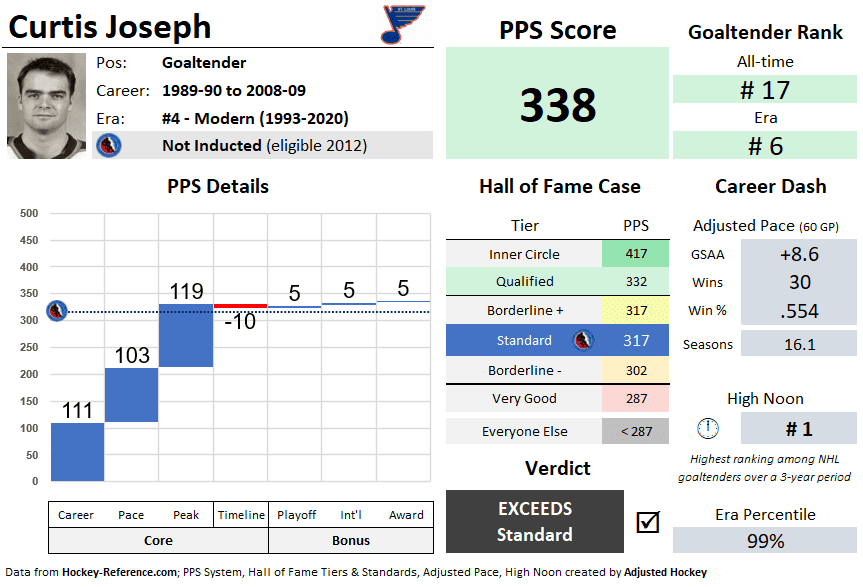
Growing up as a goaltender in hockey-mad Sudbury, Ont., Paul Pidutti has been fascinated by the Hockey Hall of Fame for as long as he can remember. The debates, the statistics, the merits of each individual case consumed him.
And during the pandemic lockdown in 2020, the KPMG accountant by trade, now 36, realized an opening to contribute to the conversation and scratch a lifetime itch.
Pidutti’s mission was bold: Boil down an entire NHL career to reflect a player’s Hall of Fame worthiness with one comprehensive number.
For the last two and a half years, he’s spent more than 2,000 hours – most days before sunrise, before punching the clock for his day job – building a database and tinkering and tweaking his formula. Now, as the Hall is set to induct the Class of 2022 in two weeks on Nov. 14, Pidutti is ready to share his passion project with the hockey world.
The Pidutti Point Share system (PPS) debuted on his web site, Adjusted Hockey, last week.
“It’s really exciting for me because really, for the first time, we’re putting every player in NHL history on a level playing field with a data-driven approach,” Pidutti said. “There was so much trial and error to get to this point, but it’s all intended to be objective. At the end of the day, the selection process still has a qualitative factor – and that will always be the case and impossible to fully measure.
“But these metrics are supposed to be the starting point for debate.”
Part of Pidutti’s motivation to contribute is the secret-ballot process the Hall’s 16-member Selection Committee uses. Unlike the Baseball Hall of Fame, where exact ballot percentages and thresholds are published, the Hockey Hall of Fame keeps information such as which players were debated or considered private and confidential – and that may stifle some of the debate.
He saw just how powerful data can be for a candidacy in 2016 and 2017 when public interest essentially got former Montreal Expos star Tim Raines elected to Cooperstown. Fans talked about it, presented a compelling case, and more or less created media (elector) pressure that lifted Raines from 50 percent of ballots north of the required threshold of 75 percent.
“Maybe the Hockey Hall of Fame hasn’t done the best job in promoting the debate because of the process,” Pidutti said. “I know it’s a respect thing, and I certainly don’t intend to rattle any of those cages. I don’t want to be a ‘know-it-all’ when it comes to the work I’m doing. I’m just looking to add reference and data points.”
The first step in Pidutti’s process was to create a level playing field – which is easier said than done for a league that spans more than 8,000 players over 104 seasons. Players were classified in five different eras, roughly 25 seasons each, which accounted for changes in league structure, schedule, rule changes, equipment, playing style and statistical averages.
Borrowing from baseball, the next step was to focus on each player’s on-ice contributions from a data perspective. He measured output, efficiency (pace) and dominance (peak), then adjusted for relative league strength from the eras. Pidutti also factored in adjustments for Stanley Cup contributions, international play and individual player awards.
Finally, and perhaps the toughest part of the equation, Pidutti worked through the careers of all 207 player inductees dating back to the founding of the game and set the ‘Hall of Fame standard’ for each position to use as a baseline. From there, he set tiers for each player relative to their position and era: inner circle, qualified, borderline plus/minus, Hall of ‘Very Good’ and ‘Not a HOF Candidate.’
He then sorted each of the 8,000-plus players in NHL history based on the formula. The end result is a PPS Player Card for each individual player, which captures all of that information with that one all-important metric: the PPS score.
The current Hall of Fame standard for forwards of the modern era is 235 PPS. How far above or below a player falls relative to that number should determine the strength or weakness of their case for Hall induction.
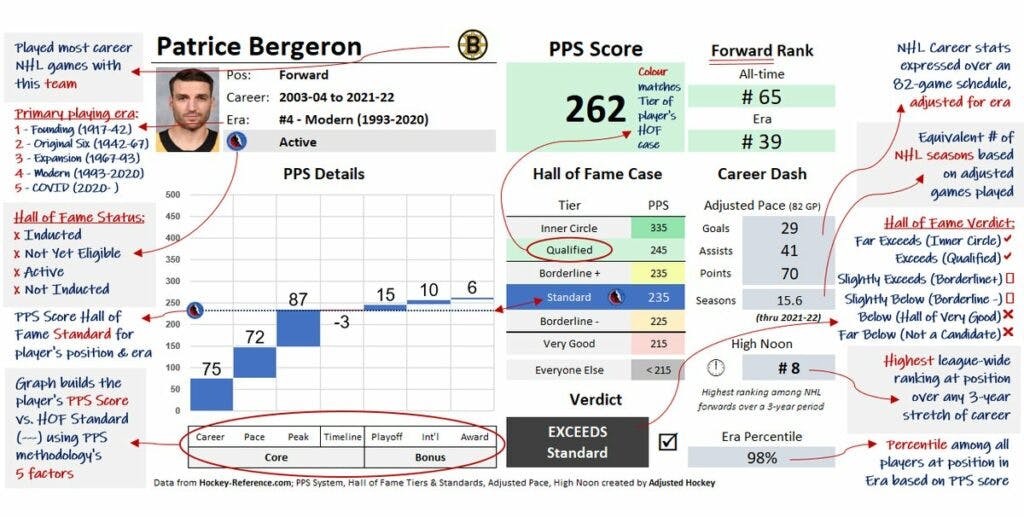
Along the way, there was no shortage of adjustments Pidutti found himself making.
“One of the hardest things was tweaking the formula so that it wasn’t just rewarding the compilers, and highlighting players who were truly exceptional for five or six years, as the Hall has with Cam Neely, Pavel Bure, Peter Forsberg and Eric Lindros, among others,” Pidutti said. “It’s a delicate balance because there is also merit for players who played a long time, those compilers, who might have never been better than the 20th best player at his position over those years.”
For that reason, Pidutti also came up with a “High Noon” metric, in a nod to his favorite band in The Arkells. That metric acknowledges a player’s rank by position over a three-year rolling average, roughly in equivalent to the way the World Golf Rankings work.
To this point, Pidutti hasn’t put all of his PPS Player Cards online or in a searchable database. There is a lot of work to be done. But his research has already yielded some fascinating data points, sure to spark debate.
For instance, almost all casual observers point to New York Rangers stalwart Henrik Lundqvist as a shoo-in for induction in the Class of 2023 next year as a first ballot inductee. And Lundqvist is more than qualified, according to the PPS model.
But his case and career is almost virtually indecipherable from Curtis Joseph, who has been eligible for induction since 2012. Joseph has been passed over 10 times.
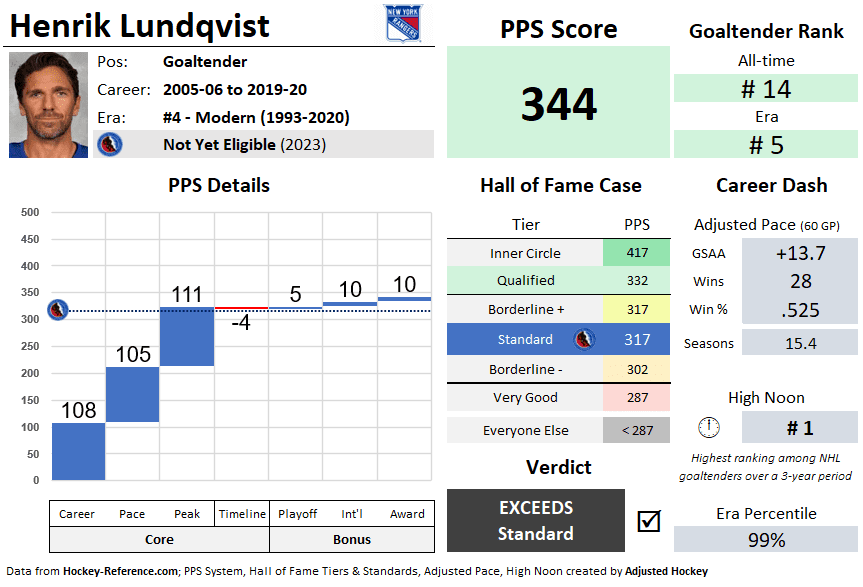
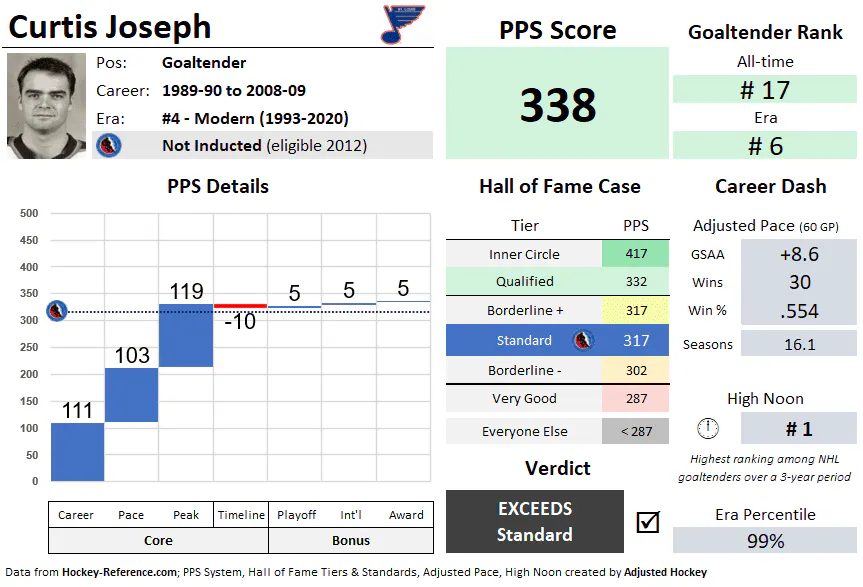
And as much as goaltenders have been underrepresented in the Hall, there is a whole host of players from the “Dead Puck Era” in the mid-90s before the 2003-04 lockout who have been overlooked, according to Pidutti’s model. John LeClair, Pierre Turgeon, Keith Tkachuk, Alexander Mogilny and Theo Fleury are part of that group – although all five of them have received some sort of debate in the public sphere in recent years.
The interesting part of the PPS project is that it can shed a light on players who have not been talked about much, such as the fact that Milan Hejduk’s career is more or less indistinguishable from Mike Gartner.
“This project can blur the hype of the 80s scorers and properly compare them to the 90s guys who received far less attention,” Pidutti said. “Now, they’re all on a level playing field.”
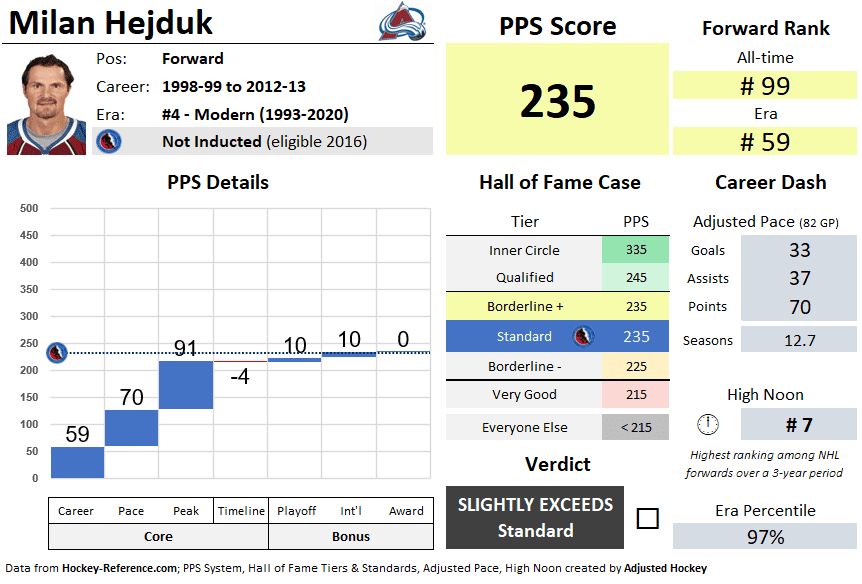
Working through the ‘Hall of Fame standard,’ of course, revealed a number of players who have been inducted but then actually fell short of what the PPS standard appears to be.
Pidutti said there are currently 44 players not inducted which meet or exceed the ‘standard,’ and thus, 44 players inducted which fall below. He wouldn’t reveal which, but some of the more recent inductees such as Guy Carbonneau and Rogie Vachon – two players who were eligible for quite a while – would be solid guesses.
That means the ‘standard’ changes with each successive Hall of Fame class, which means the project will always continue to evolve, and the debate will rage on forever. And that’s really the point.
“There is still so much work to be done and I’m excited to get it off the ground,” Pidutti said. “There’s always going to be a qualitative factor that no formula can replicate. I’m not a know-it-all. It’s not all-encompassing. I’m just looking to create conversation around the Hockey Hall of Fame. This is the starting point of the debate.”
_____
POINTSBET IS LIVE IN ONTARIO. PLAY NOW!

Think you know sports? PointsBet Canada is live in Ontario!